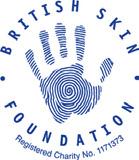Leading the fight against skin disease

 British Skin Foundation
British Skin Foundation


 British Skin Foundation
British Skin Foundation
As the world began to find its feet with our ‘new normal’ this year, the British Skin Foundation team have continued to work tirelessly, raising money for skin disease research.

Funding research is at the heart of what we do and we have been able to continue to support some incredible, pioneering research. Head to pages 10-11 to find out more about the research grants we are currently funding.
As ever, our supporters have taken on a huge variety of challenges in the name of fundraising - cycling from Land’s End to John o’Groats, trekking through the Sahara Desert and running in the Berlin Marathon to name just a few. We are endlessly grateful for the time, effort and dedication put in to achieve fundraising goals. Read more about some of our wonderful fundraisers on pages 5-7. Perhaps you will be inspired to make 2023 the year you take on a challenge of your own? Head to page 3 for some ideas.
We are thrilled to announce that Her Royal Highness Princess Beatrice has become our new Patron. Princess Beatrice brings a wealth of knowledge in supporting charities as well as public exposure to the vital work we do.
We were delighted to partner again this year with ITN Business on a news-style programme called ‘The Ages of Our Skin’. The programme explored how our skin changes throughout our lives and the developments in dermatology that aim to benefit skin of all types and ages. Learn more on page 13.
Thank you again to all our wonderful supporters, old and new, who have allowed us to continue our fight against all skin conditions. If you can, please support us in 2023 and help us to take one more step towards eradicating skin disease and skin cancer.
Patey British Skin Foundation Chief Executive Officer





Why not take on an event in 2023?
For more info contact events@britishskinfoundation.org.uk or visit britishskinfoundation.org.uk/Pages/Events/Category/events
Running
Brighton Marathon Sunday 2nd April
London Landmarks Half Marathon
Sunday 2nd April
Brighton 10K Sunday 2nd April l
Manchester Marathon Sunday 16th April
London Marathon Sunday 23rd April
Isle of Wight Challenge
Saturday 29th - Sunday 30th April
Jurassic Coast Challenge
Saturday 13th - Sunday 14th May
Hackney Half Marathon Sunday 21st May
London 2 Brighton Challenge
Saturday 27th - Sunday 28th May
Edinburgh Marathon Festival
Saturday 27th - Sunday 28th May
Cotswold Way Challenge
Saturday 24th - Sunday 25th June
The Cardiff Half Marathon
Sunday 1st October
Treks
Easter 50 Challenge Saturday 1st April
Lake District Challenge
Saturday 10th - Sunday 11th June
Peak District Challenge
Saturday 8th - Sunday 9th July
Snowdon at Night
Saturday 5th - Sunday 6th August
Everest Base Camp
Thursday 9th - Sunday 26th November
Cycling
London to Paris Tour De France Edition
Wednesday 19th - Sunday 23rd July
Euro City Cycle
Friday 6th - Tuesday 10th October
Donate britishskinfoundation.org.uk/appeal/donate
2022 was another tough year for fundraising as Covid-19 restrictions meant uncertainty remained high. However, teams did not allow this to stop them and we saw a huge amount of hard work and creativity to continue fundraising.

A huge congratulations to Glasgow DermSoc for being this year’s Battle of the DermSocs Champion. From burpee challenges and bake sales to an impressive dermatology conference with fantastic speakers, Glasgow DermSoc raised an incredible £2,079.
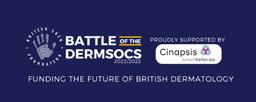
Newcastle DermSoc received the award for the Most Creative DermSoc with a charity head shave like we had never seen before. We loved the idea, the creativity, and the commitment to the cause!
Another big well done to Birmingham DermSoc on the award for Best Media Presence for their hard work, consistency and social media magic.
The British Skin Foundation and the Battle of the Dermsocs committee are entirely grateful to all the teams who took part in the competition and helped raise money for vital dermatological research.
We would also like to say a special thank you to this year’s Battle of the DermSocs committee: Dr Ewa Kloczko, Dr Sukhjit Dhariwal, Dr Manpreet Sagoo, Dr Giulia Rinaldi, Dr Olivia Knowles, Yasmin Nikookam, and Lucy Mackie.
Our annual fundraising competition for medical students and junior doctors in University Dermatology Societies.
This year has seen some of our amazing fundraisers taking on difficult challenges to raise funds for our research. A huge thank you and congratulations to all of this year’s fundraisers, we could not do what we do without you all!
Inspired by his work as a dermatologist, Phillip decided to take on the challenge of cycling from Land’s End to John o’Groats with his brother-in-law, Ben. The challenge involved just under 900 miles of cycling and over 40,000 feet of climbing as well as an extra dose of unpredictable weather.
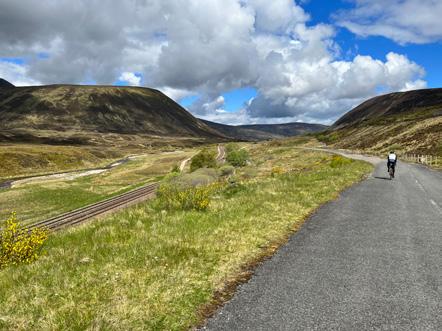
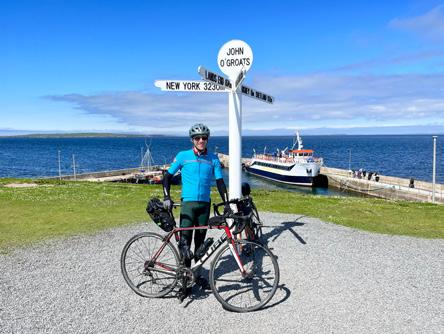
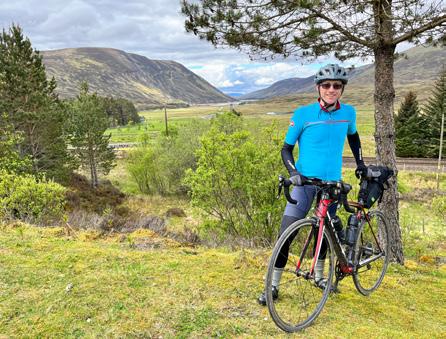
‘
The ride was a massive challenge and I was always pleased to be getting off the bike at the end of the day! Liverpool and the surrounding area was very cold and wet which made for a tough day in the saddle. I was riding about 10 hours per day and covered 160 miles per day for the first 4 days. Scotland was absolutely beautiful with spring blooms out in full force. LEJOG has been a long standing ambition and I was so pleased to reach the finish - I genuinely didn’t know whether I would be able to make it.’
Phillip raised £1893.75 for the British Skin Foundation! Congratulations Phillip!
After losing his wife Lisa in 2020 to a rare condition called Mycosis Fungoides, a cutaneous T-cell Lymphoma which attacks the skin causing skin lesions, Danny Carter decided to fundraise for the British Skin Foundation by cycling from London to Paris.
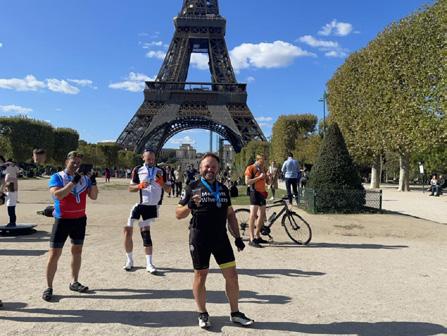
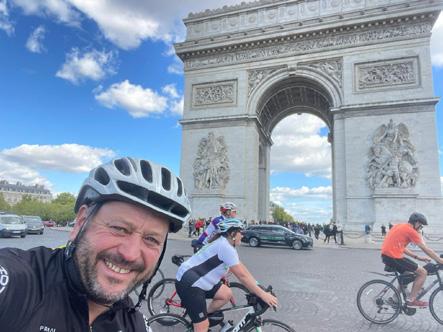

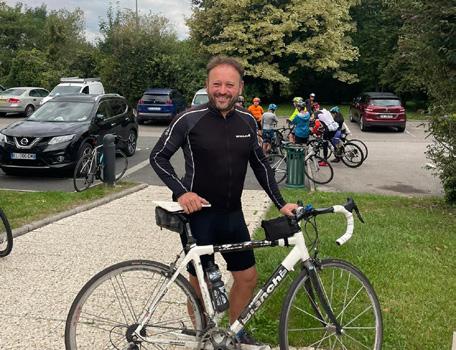
Danny and his wife Lisa completed the ride together in 2019 and raised an incredible £595 for skin disease research.
Danny’s reasons for taking on the challenge again are best described in Lisa’s words, reflecting back to 2019.
'This has been a particularly tough year for me living with an undiagnosed (to date) skin condition which has all but consumed my whole body, my all day and my everyday. I get through this because of my wonderfully supportive husband, my family and closest of friends and gallons of lotions and potions. The British Skin Foundation helps to fund research into all types of skin diseases including psoriasis, eczema, alopecia and melanoma skin cancer. Even when skin diseases are not life threatening they affect everyday life, mental health, relationships and work life.'
Danny said — ‘ I hope by doing this ride, I can help find cures and treatments that will dramatically improve the quality of life of someone like Lisa with a skin condition and prevent them from enduring what she did.’
Danny has raised £892.50 to continue the fight against skin disease. Thank you Danny!
You may remember from last year’s newsletter that skin therapist Rebecca Graham was planning on taking on a gruelling 100km, 5 day trek across the Sahara Desert. Despite two pandemic related postponements, she finally completed her challenge!
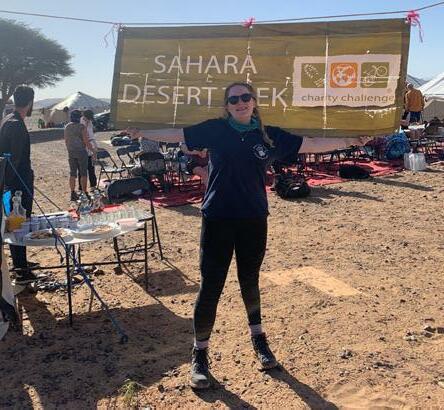
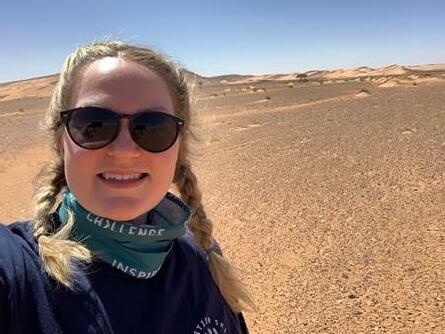
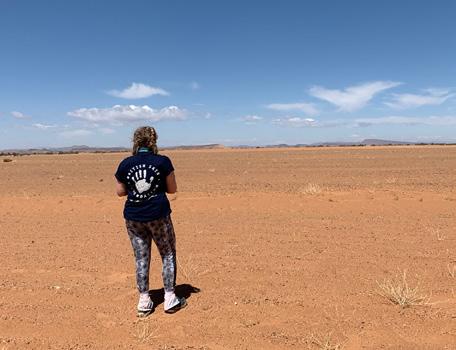
Rebecca commented — ‘The trek was challenging, unexpected, an emotional rollercoaster, but more than that it was the absolute experience of a lifetime that I will never forget. There are just no words to describe the vastness and beauty of the desert. Yes, we fought the toughest weather with the biggest blisters imaginable, but we also witnessed the most amazing sunsets, sunrises, and undisturbed night skies. I have made friends for life and am so proud to be making a difference to the lives of those facing skin disease and skin cancer.’
Rebecca was able to raise £2358.63 to go toward skin disease research. Well done Rebecca!
Head back twenty-five years and you would find a world where the Spice Girls are still together, Titanic is in the cinema and the sound of dialup internet is ringing in our ears. A lot has changed in the last two and half decades and amongst all the cultural shifts, the world of dermatology has seen a seismic change.
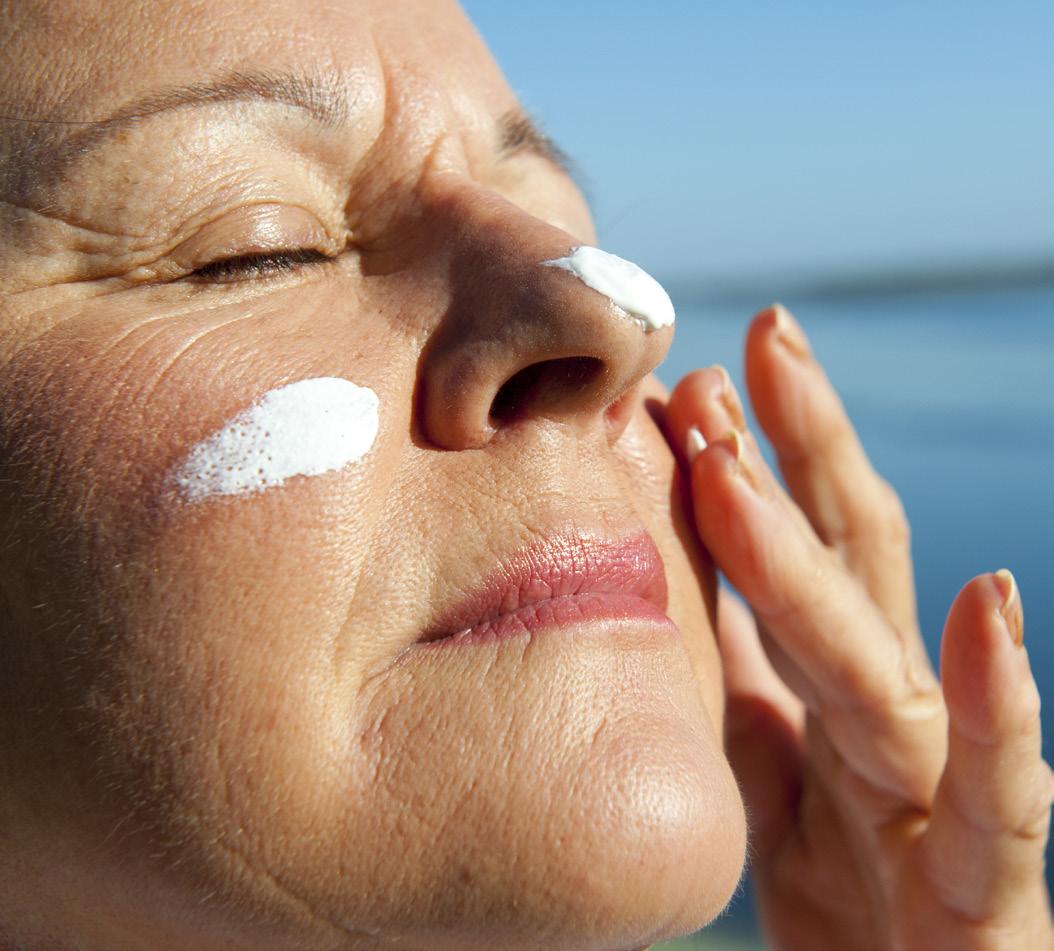
When the British Skin Foundation was launched in 1996, dermatology was reserved primarily for those within the medical profession. If you stopped people on the street and asked them about their skin care routine, you would have been met with many blank faces. Twenty-five years has changed that. With the invention of the internet and information being made more accessible, the perception of dermatology changed. The public slowly realised the importance of looking after their skin and began to take an interest, both medically and cosmetically. With this surge in interest, more people began knocking on our door looking for information. There was a clear demand for scientifically backed research presented in an easy-to-understand way.
The culture around our skin and appearance has shifted. We are now constantly photographed, curating an image of ourselves to share over social media, and being bombarded with products that promise the world. We have an unprecedented desire to look after our skin cosmetically and research shows that our skin is intrinsically linked with our self-confidence.
We are also increasingly aware of the signs of skin disease, the treatments available to us and methods of prevention. Whilst twenty-five years ago sun cream might have been hastily applied on a hot summer’s day at the beach, the importance of daily SPF is now common knowledge.
We are more aware than ever of how important science and research is and being able to access that information gives us a power over our own skin health we previously did not have.
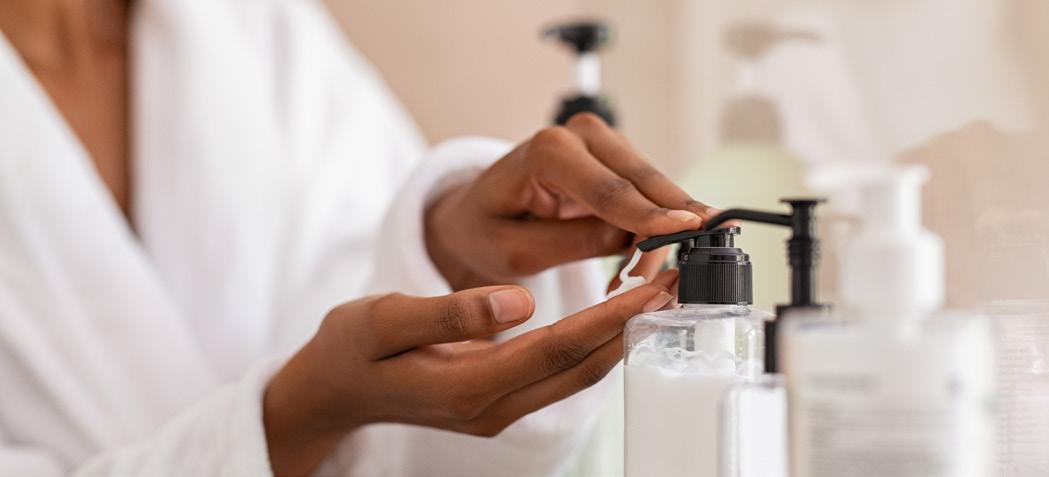
We are more aware than ever of how important science and research is and being able to access that information gives us a power over our own skin health we previously did not have. Being able to carry out your own research, accessing information about your condition and contacting your doctor from a place of knowledge is not only beneficial to you but is often encouraged by medical professionals themselves.
The British Skin Foundation began solely as a research body, funding projects that investigated all types of skin conditions. Whilst that is still a fundamental pillar of the charity, education and information has now become equally important. In a world of far-reaching misinformation, providing a reliable source that allows everyone to learn about their own skin conditions has never been so important.
Matthew Patey OBE, CEOThe British Skin Foundation funds work in research institutions all across the United Kingdom. These are the projects we are currently supporting and the outcomes we hope to achieve.
 Manchester London
Hull
Bradford
Glasgow Bath
Birmingham
Dundee South Warwickshire
Nottingham
Newcastle
Dublin
Manchester London
Hull
Bradford
Glasgow Bath
Birmingham
Dundee South Warwickshire
Nottingham
Newcastle
Dublin
London
— Researchers look at the response of skin cells to ‘stress’ on the palms and soles to understand why unusual skin lesions develop there.
— A study aiming to understand why many people with atopic eczema and psoriasis suffer with their mental health.
— An investigation into new methods of treating fungal infection using small metallic particles of silver and copper are evaluated.
— Researchers are investigating whether a subgroup of cells, called eosinophils, found in the blood, are involved in inflammatory rashes or skin cancer.
— A study looking into male genital lichen sclerous, a common scarring rash that affects the male genitals.
— Investigators are looking for a marker visible down the microscope, that will identify squamous cell carcinoma skin cancers. Squamous Cell cCrcinoma typically has a worse prognosis, meaning that it should receive more aggressive local therapy to begin with.
— A study investigating the contributions from hormones, genetics and other influences on Frontal Fibrosing Alopecia to understand more about hair loss in general.
— Researchers are looking at pigment cells that make the skin cancer, malignant melanoma, and how these cells might avoid detection by the body’s immune system.
— A study looking at the inheritance of a sun-sensitivity disease called solar urticaria.
— An investigation of the degree to which inflammatory cells contribute to ageing of the skin.
— This study looks at the cells involved in the production of keloid scars, with the hope that better understanding might aid treatment.
— An investigation into the common scarring condition of female genital lichen sclerosus and what immunological mechanisms might be behind it.
— A study looking to Optimise the Contrast Agent Injection Protocol for Magnetic Resonance Lymphangiography of the Lower Limbs
— A study of the relationship between the pigment cells of malignant melanoma and other cells in their vicinity in the skin.
— A look at the local factors that allow the skin cancer, squamous cell carcinoma, to spread locally.
— An investigation into mechanisms by which azathioprine, a drug used to treat a number of skin conditions, can predispose to skin cancers.
— Investigators are working to develop a better method for diagnosing skin conditions characterised by sensitivity to light.
—
A study looking at local factors in the spread of squamous cell carincoma.
— An investigation into the mechanism of wound healing.
— A study of the role of a specific inflammatory molecule, IL-36gamma, in skin inflammation caused by microorganisms.
Dublin
— A look at fats on the surface of the skin and their role in skin health.
— A study of whether the diabetes drug metformin can help with the scarring disorder hidradenitis suppurativa that affects the armpits and groin.
Researchers are looking to develop a new treatment for the sun damage lesions, actinic keratoses, using natural light.
Hull
— A study into whether bacteria that can colonise wounds play a part in the healing of wounds.
Newcastle
— A further look at what local inflammatory cells in the skin cause the scarring and discharging condition hidradenitis suppurativa to develop.
— A study into how communication between cells can influence the local spread of the skin cancer malignant melaoma.
— A look at the role of abnormal collagen in a rare genetic disorder, CYLD cutaneous syndrome.
Birmingham
— A study of the role of the bacterium, Staphylococcus aureus, in atopic eczema, and how modification of this microorganism might help in treatment.
— A study of a test to help with the diagnosis of a type of skin cancer called mycosis fungoides.
Manchester
— Researchers are developing a register for patients with alopecia areata in order to study which treatments might help.
Nottingham
— A look at the best way to ensure that all the tumour has been removed during the procedure for skin cancer know as Mohs’ micrographic surgery.
— An investigation to develop a better understanding of the changes within a type of skin cancer known as keratoacanthoma, in the hope that these might lead to improved treatments.
Research is the only way to get closer to a skin disease free world but research is very expensive. It is often difficult for researchers to gain funding at the beginning of their projects. As the only UK charity raising money for research into all skin diseases and skin cancer, we are often in a position to fund pilot research that may otherwise not be funded. Without grants from the British Skin Foundation many research projects would never be able to get off the ground. Your support will ensure that skin disease research is able to continue innovating and progressing in order to save lives.
Your legacy could make a huge difference in the fight against skin disease and skin cancer. By choosing to leave a gift in your will to the British Skin Foundation, you are helping to fund groundbreaking research. What will your legacy be?
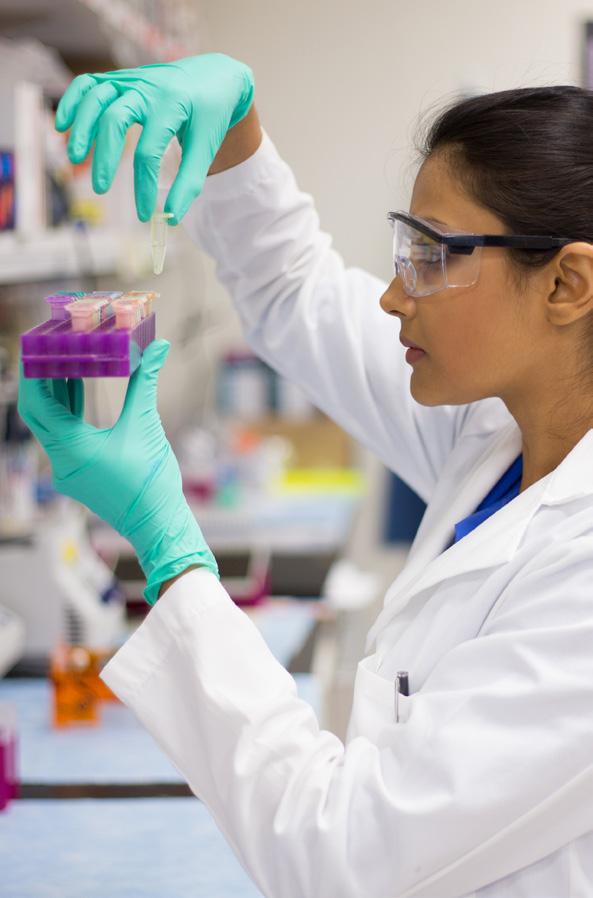
We know wills and legacies are not something many of us want to think about. We often choose to ignore them and leave it for another day which is why 60% of adults in the UK have not currently got a will in place. But having a will helps to save time, money, and stress for your loved ones. It may also help to make skin disease and skin cancer a thing of the past.
In June 2022, the British Skin Foundation and ITN Business collaborated for a second year to launch a news-style programme raising awareness and understanding of skin health and the different skin conditions across the ages.
Anchored by presenter and journalist Louise Minchin, “The Ages of our Skin” featured a studio interview with Consultant Dermatologist Dr Anjali Mahto and the BSF’s CEO Matthew Patey discussing skin concerns across the ages, deceleration of the ageing process, and the work the BSF are doing to address the minefield of information and misinformation available.
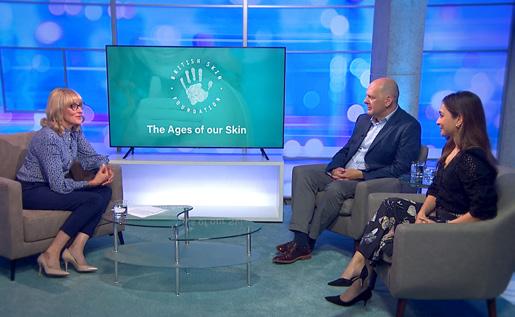
The programme also featured Consultant Dermatologist Dr Emma Wedgeworth with patients ranging in age from 10 to 71, discussing their experiences with skin conditions including acne, eczema, skin cancer, sweet syndrome and Dominant Dystrophic EB. The Ages of Our Skin also included five reporter-led films from partners Ameliorate, Boots, Dermal, Olay and Sanofi.
‘Throughout our lives our skin changes and, with that, how we need to look after it changes. At the British Skin Foundation, we know how important it is to be able to access trusted information to help with your skin through the different stages of life.
Working with ITN Business has given us the opportunity to raise awareness of skin health and highlight the important work both we and our partners do.’
 — Matthew Patey CEO , British Skin Foundation
— Matthew Patey CEO , British Skin Foundation
To view the full programme visit britishskinfoundation.org.uk/the-agesof-our-skin
If your company is interested in taking part in our next programme please get in touch partnerships@ britishskinfoundation.org.uk
With thanks to Ameliorate, Boots, Dermal, Olay and Sanofi. We’d also like to thank those who shared their skin stories and the professors, doctors and experts for sharing their knowledge.
Growing up with fair-hair and lots of moles has meant I’ve always had an awareness of my skin. For the entirety of my life so far, I have been reminded to lather myself in sun-cream every time a glimmer of sun pokes through the clouds. The words ‘skin cancer’ would casually be thrown into conversation, a notion that seemed so improbable.
During my 22 years of existence, I had never routinely checked my skin; but in August 2021, I caught a glimpse of an unfamiliar mole on my back. I was referred to a dermatologist by my GP and within 2 weeks I had seen a consultant who informed me I would need a biopsy. The procedure was explained and before I knew it, I had lost a mole and gained a new scar! (Yup… that diddy black mark on my back really can be fatal).
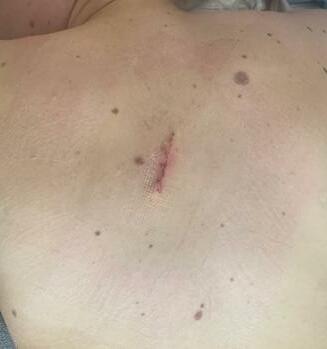
My life continued as normal: I went to work, had a blast with friends and family, never anticipating the phone call I was to receive.
“…unfortunately you have Stage 1 Melanoma…we will need to operate and remove more of your skin”
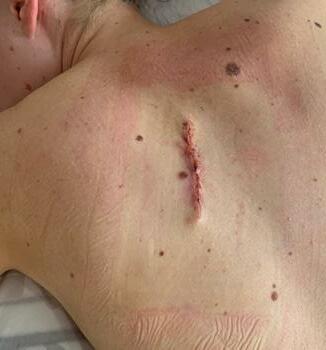

I made the conscious decision to think only in a practical way, suppressing any emotion.
I focused myself on booking sick leave, cancelling plans, bulk buying wound dressings and digging out my loose-fitting clothes. ANYTHING to distract myself.
In October ‘21 melanoma gifted me with a significantly larger and more painful scar. The frantic preparation was over, I could only rest, and suddenly I was left solely with my mind. For someone who is normally pretty good at understanding her emotions, I felt completely hopeless at managing my complex thoughts and feelings, totally overwhelmed by an abundance of fear, confusion, sadness, anger and guilt. The pain meant I was unable to wash or dress independently, completely reliant on my wonderful mum in order to meet my basic human needs. Just to look at my scar made me cry, and not because of what it looked like, but because it was a constant reminder of what felt like a terrifying reality. The emotional toll was unexpected and completely exhausting.
But, as with everything in life: time heals…
A starting thought: our skin is our largest organ, but have you ever been formally educated about the risks that come with it?
Nine months on and I can confidently say that I have my mojo back! My life is just as (if not more) fulfilling than it ever has been before. Regular hospital visits for what I like to refer to as my ‘full body MOT’ provide the invaluable reassurance that my skin is behaving and I am melanomafree. Meanwhile, a fantastic support system has enabled me to slowly unpick my thoughts and feelings and address them in a way that allows me to live in normality.
Of course, life would have been far more simple if the past year had not been so heavily dictated by melanoma. But despite this, I will never forget how lucky I have been. I have a parent who has never stopped nagging me about my skin, and a career in the medical world. It is these two things, teaching me to act quickly enough, which has ultimately saved my life.
However, there are many people who do not have the same understanding or appreciation for their skin. The education system does not teach you about skin cancer, social media sets an unrealistic standard of beauty based on how bronzed you are, and as Brits, we are so excited by the prospect of warm sunshine, that we completely neglect our skin when we finally see it.
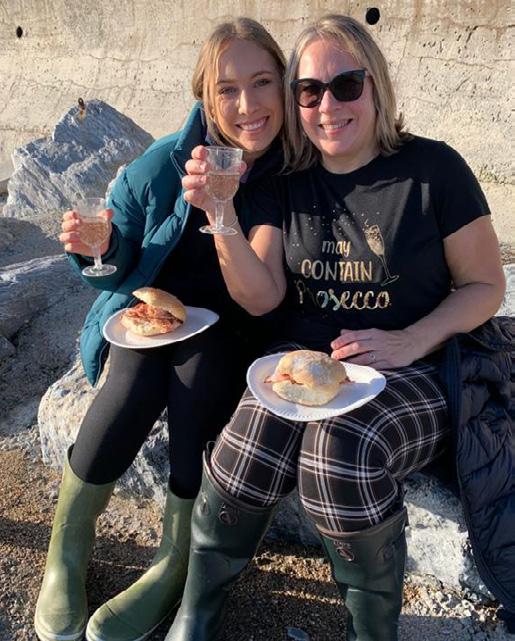

Take time to know your own skin and give it a regular check. Educate yourself on the signs of skin cancer and never be afraid to ask if you are unsure. I am living a wonderfully happy life because I knew to do these things, and it is my mission to make sure others get that chance too. Please, continue the conversation about skin cancer and remember to check your skin.
— Molly BrownMelanoma is a cancer of the pigment cells of the skin. If it is treated early, the outlook is usually good. Three quarters of the people who have a melanoma removed will have no further problems. However it is crucial for a melanoma to be removed as early as possible – before it has had time to spread deep into the skin or to other parts of the body.
It is vital to check your skin about once a month for moles or marks that are changing or new. In adults, about 70% of melanoma cases are not associated with existing moles but form as new marks on the skin. Melanoma is one of the most dangerous forms of skin cancer. The new mark may look like a mole, a flesh coloured bump, a flaky, raised coloured patch or a spot that will not go away.
Changes to look for Any changes can be a concern, but in particular look out for growing size, changing shape, developing new colours, bleeding, pain, crusting, red around the edges or itching.
Get changes checked by a doctor straight away Tell your GP about any changes to a mole or patch of skin, or a new mark on adult skin. If your GP is concerned, they can refer you for free through the NHS to a skin cancer specialist, usually a Consultant Dermatologist - an expert in diagnosing skin cancer.
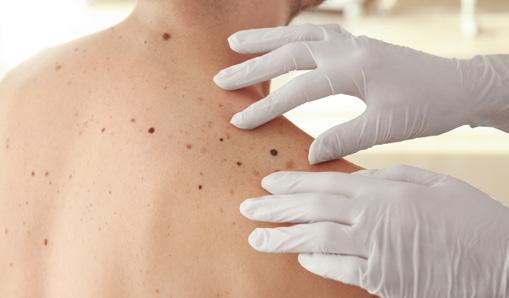
Remember to examine your skin in a well lit room. It's best to get someone to help you - they can see the areas you can't. If you can't find someone to help, use a full-size mirror and a handheld mirror to see the back of your body.
— First, inspect your face and scalp closely. Use a blow dryer or comb so you can see your scalp. Use the mirrors to see the back of your head and neck if alone.
— Next, check both sides of your hands (including fingernails and palms) and forearms before moving up to your elbows and upper arms.
— Now check your neck, chest and torso. Ladies - don't forget the underside of your breasts. Lift your arms to check your sides.
— With assistance from your helper or your mirrors, examine your back, buttocks and back of your legs.
— Then, sit down and check the rest of your legs and genitals.
— Lastly, check your feet including your soles.
If you see the British Skin Foundation logo on a product
this means that the research behind it has been validated by our dermatologists.
As one of the UK’s leading supporters of skin disease research, the British Skin Foundation is on occasion approached to independently review the extensive research that companies undertake to ensure their products are not detrimental to the users’ skin health.
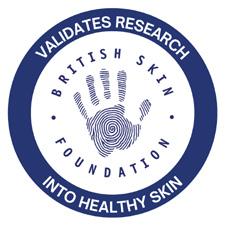
This review is led by a professional panel made up of at least two independent BSF consultant dermatologists, one of which will be an expert from within the field of study. The BSF panel review the technical and clinical data supplied by the companies’ research and development team. As well as electronic presentations, subsequent face to face interviews are often necessary to thoroughly cover every aspect of the science behind the product.
On the basis of the information shared, the BSF panel will then decide whether to recognise that a product fulfils its stated objectives and that every measure is taken to ensure it is not harmful to users or detrimental to skin health.
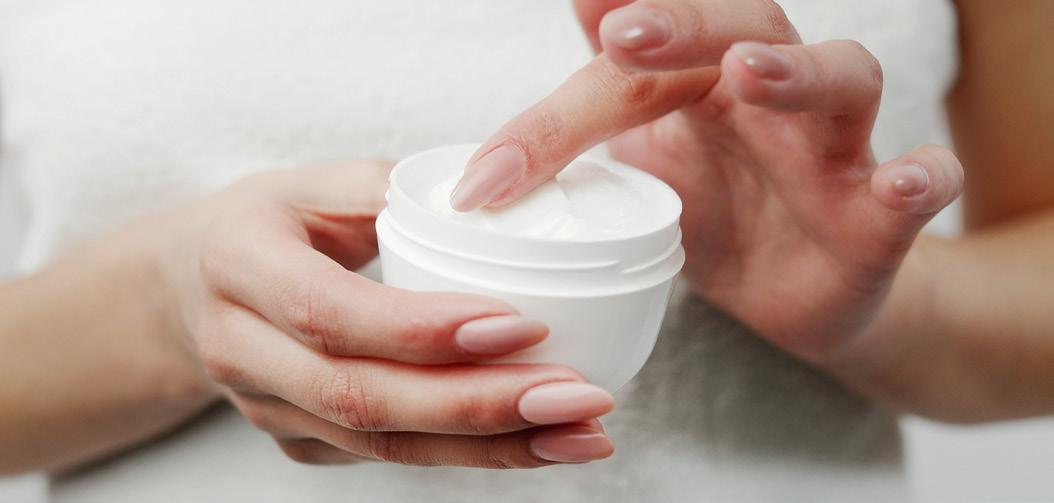
BSF research recognition is neither an endorsement of efficacy nor an indicator of market leadership.
The BSF and its panel conduct this work voluntarily, preferring that the companies concerned recognise its main aims and objectives and choose to charitably support skin disease research.
If you would like more information or if your company would like to fundraise or partner with us, please get in touch via partnerships@britishskinfoundation. org.uk
Adult acne is defined as acne occurring over the age of 25. This could be acne that has persisted since adolescence, new onset acne first presenting in adulthood, or recurrent acne. Persistent acne is the most common form.
As dermatologists, we have been observing a rising number in cases of adult acne in the past 10—15 years. The causes of this are yet to be fully elucidated. There are potentially complex interactions between genetics, hormones and hormonal fluctuations, chronic activation of the innate immunity as well as environmental factors, such as a Western lifestyle and chronic stress.
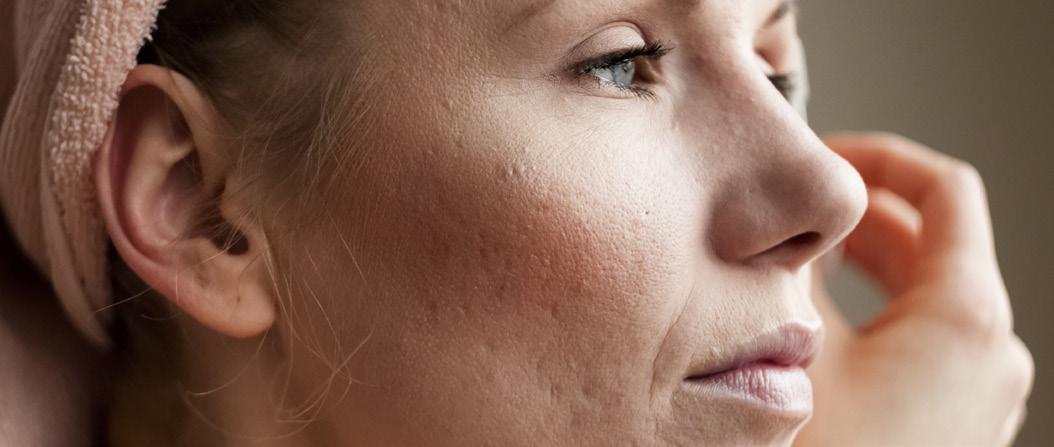
In addition to non-inflammatory lesions such as blackheads and whiteheads (small bumps under the skin), acne sufferers can get troublesome inflamed spots such as papules and pustules, and larger, painful lesions such as nodules and cysts, which can persist for weeks, sometimes leaving scars.
Acne is generally associated with a higher incidence of anxiety, depression and low selfesteem. Adults in particular report that they feel like teenagers and that they should have “grown out” of their acne by now. They feel that their acne keeps them back at work and that they are often perceived as not professional enough due to their skin. Having an acne break out can mean they avoid or cancel planned social activities. Patients with acne often report their skin can have a negative impact on their relationships.
My main advice would be that adult acne is treatable and it is not something that one needs to put up with or give up on. There are many effective treatments for acne, so do please seek medical advice if this is a persistent problem or affecting your mental health.
The aetiology of acne is multifactorial and includes having a genetic predisposition to acne, excess oil production, a tendency to blocked pores, the presence of bacteria (C.acnes), and inflammation. Androgens (male hormones), present in women as well as men, can stimulate excess oil production in androgen-sensitive individuals. The long term presence of certain C.acnes strains on the skin contributes to an imbalance of the skin microbiome and triggers inflammation in acne.
Acne treatment in adults consists of a variety of topical preparations and oral medication, however adult acne is often more resistant to standard treatments. Topical ingredient combinations including retinoids and benzoyl peroxide or topical antibiotics, can be useful on their own or in conjunction with oral medication. While a 3 to 6-month course of tetracyclines can help settle things down temporarily, adult acne can recur after treatment discontinuation. A course of oral retinoids such as isotretinoin can be very effective in achieving long term acne clearance in adults with persistent or troublesome acne, though there is a potential for side effects and therefore patients need to be carefully monitored during treatment. Spironolactone is an oral anti-androgen treatment used quite effectively in the long-term management of female adult acne.
Unfortunately, adult acne cannot be fully controlled with lifestyle measures or diet alone. Some studies suggest that an excess of dairy, especially low fat, can trigger break outs in a small minority but certainly not all acne sufferers. A high glycaemic diet with an excess of refined carbohydrates could also serve as a trigger for some. As such, we would not advise that anyone follow a restrictive diet but that they lead a healthy lifestyle and moderate potential triggers if they apply to them.
Certain heavy or pore-blocking (comedogenic) cosmetics may aggravate some people’s skin and therefore products suited to acne prone skin are recommended. Chronic stress is thought to aggravate many skin conditions, including acne, though controlling this is not easy in modern society.
Consulting a doctor
Acne sufferers should consult their doctor if they are getting persistent acne, especially if it is not under control with over-the-counter treatments or causing scarring, or if it is impacting their mental health and social interactions. Acne treatments are available for any age and stage of the condition.
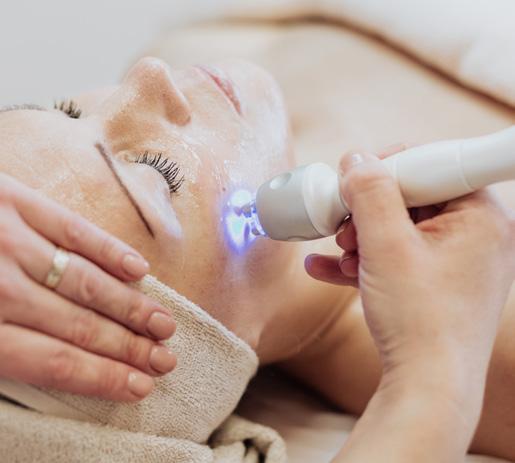
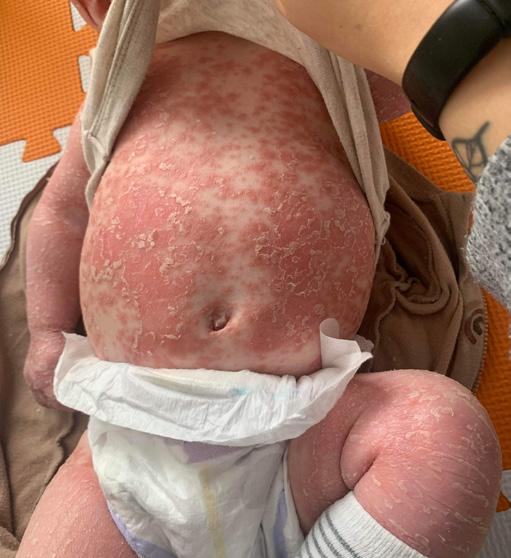 Pityriasis Rubra Pilaris
Pityriasis Rubra Pilaris
After giving birth to our son Trent, my husband and I thought we were ready for the challenges of a newborn again. What we weren’t prepared for was Trent being three weeks old and coming out in a rash. What began as small follicular spots and round scaly patches, quickly morphed into big patches of rash that covered large parts of his body. Small islands of sparing were left between the big patches of red - a key characteristic of what we later discovered was Pityriasis Rubra Pilaris. Within weeks, his body was 95% covered and we were dealing with an erythrodermic three month old.
I knew something wasn’t right and spent countless times at the GP who were adamant it was eczema or an allergy. We got prescribed allergy formula and steroid creams, which gave no relief. Eventually, due to the lack of response to treatment and worrying spread, we got an urgent referral to dermatology at our local hospital. We had a few further misdiagnoses, bi-weekly appointments, failed treatments, multiple professionals and A&E visits due to repeated skin infection. Finally, Pityriasis Rubra Pilaris (PRP) got mentioned. I went home and felt a huge sigh of relief when the Google images finally looked like what we were dealing with. An answer. My relief quickly turned to worry when I read further about the difficulties people with PRP face.
What I thought was just a full body itchy rash, turned out to be a disease that targets the body as a whole. Commonly, patients with PRP lose their hair, struggle with temperature regulation, cannot sweat, experience joint pain, are foggy, tired and many other physical symptoms. Trent also suffered with extreme dryness, leading to cracking, fissures and bleeding all over - this can severely affect mobility and development. He has to be creamed between 6-8 times a day to try and ease the pain, as well as being wet wrapped at night time. PRP has multiple types, each with differing symptoms and longevity. Trent is still undergoing tests to find out if he is a Classic PRP patient, meaning it was virally induced and symptoms will disappear after 1-3 years, or whether his is Atypical. Atypical is known as the Genetic variation and is associated with a CARD14 mutation - this typically means a lifelong battle, with stages of remission.
Our dermatology team had never seen a case of PRP and this seems common across the board. With the chances being around 1 in 8 million for Atypical PRP, professionals are not experiencing PRP first hand, leading to misdiagnoses and further deterioration before being taken seriously. Treatments vary and due to little research, there is not much proof as to what works. However, common pathways include oral retinoids, methotrexate and biologics. Trent is currently on a retinoid (Acitretin), with the hope of a biologic in coming months to suppress symptoms and allow him a normal quality of life.
Even after all this struggle, Trent smiles, laughs and enjoys every day. He is your typical 7 month old and loves to play. There is light at the end of the tunnel and treatments have been proven to work - it just takes a while to find the right one, due to PRP varying so heavily between each patient.

There is a Facebook support group that is worldwide and has been my biggest network for the past six months. They are knowledgeable, supportive and passionate about funding and research into PRP. A few members have come together to create a ‘Survival Guide’ which is linked for new members to read through - it has every question you could possibly imagine answered, with personal experiences and advice. It was a key part of pushing me through the harder days and allowing me to feel like I wasn’t the only parent in the world going through this. Hope was restored seeing remission stories and it is helpful to get personal experiences to make us aware of what Trent could be experiencing, and what we could do to help. We are hoping the future is bright and biologics are our saviour. Pityriasis Rubra Pilaris is hard, but the people who fight it are even stronger.
— Erienne on behalf of Trent
Winter poses its own problems with regards to skin conditions.
During the winter months our skin does not retain as much moisture as needed.
This may be due to a reduction in ceramides. Ceramides, simply put, are lipids or fats in the uppermost layers of the skin that play a vital role in the barrier function. Studies have shown there are reduced ceramides in the skin during winter resulting in dryness, scaling and thus lack lustre skin. You can improve the skin’s barrier function by applying regular emollients that contain ceramides and vitamin B.
A number of skin conditions such as psoriasis, eczema or seborrhoeic dermatitis tend to deteriorate in the winter. Most of the above conditions tend to get better in the sun which is why you may notice your skin flaring the winter.
Seborrhoeic dermatitis is probably the most common of the three and results in a flaky rash sometimes with greasy feeling flakes around the nose, forehead and scalp. This is caused by a yeast that lives on our skin, however due to either an overgrowth or other factors is now causing a rash to develop.
Both eczema and psoriasis may flare during the winter. With heating being turned on the skin can dry out making it more itchy and prone to flare ups. Also during the winter you’re more likely to suffer with strep throat infections, a well known trigger for a type of psoriasis called guttate psoriasis.
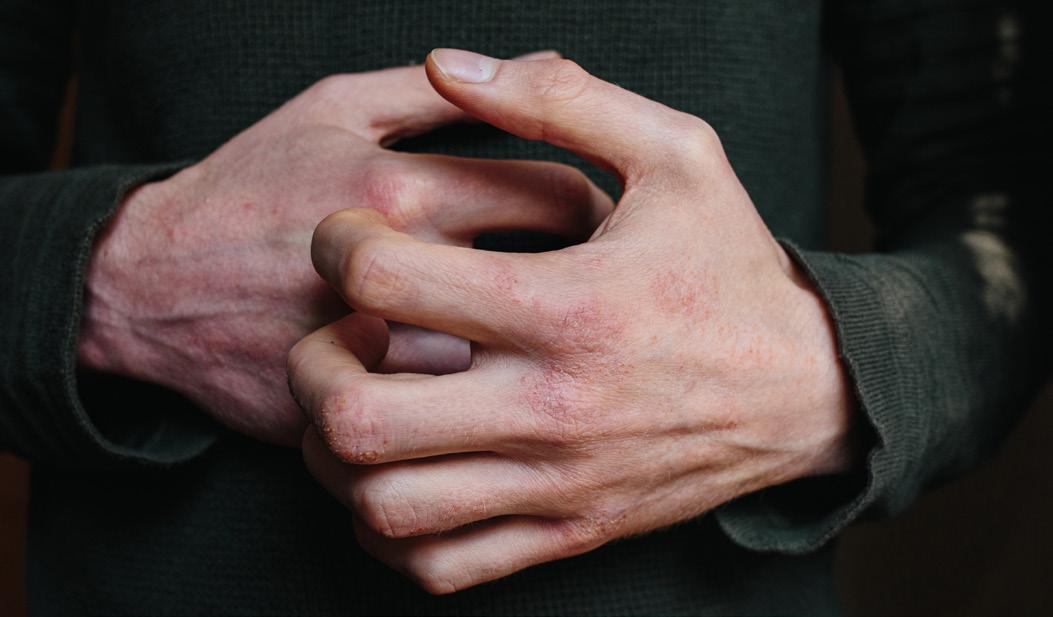
The skin on certain parts of your body is thinner and therefore will lose more fluid. Areas such as your lips, knees, elbows will often look dryer. Most of this ‘drying out’ will occur at night. So make sure you moisturise not only during the day but before sleeping. Consider a humidifier to put back some of that moisture in the air.
We tend to drink less water in the winter and will often resort to hot caffeinated drinks which act as diuretics resulting in more fluid loss. Dehydration will give a lacklustre and dull appearance to the skin. Make sure you are drinking plenty of water and not just coffee or alcohol!
What goes into your body affects the way you look on the outside. Make sure you continue to take in lots of hydrating foods including fruits and vegetables. Foods such as cucumber, spinach and grapefruit have a high water content and are also generally good for your skin.
A weekly gentle exfoliation will clear the stratum corneum. This is the top few layers of skin which is mostly comprised of dead cells. Clearing this layer will give your skin a more glowing appearance and also allow for better penetration of moisturisers.
A sunblock should ideally be used all year around. Remember that ice and snow will reflect UV light and can even increase the amount of exposure to UV radiation. Depending on your skin type use a high factor sunblock and one with high UVA star rating. This protects against developing wrinkles and importantly reduces skin cancer risk.
